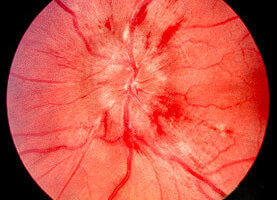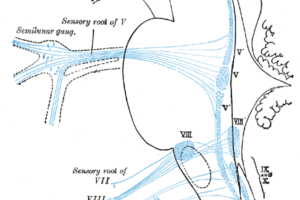A facial pain syndrome characterized by paroxysms of pain involving areas innervated by one or more sensory branches of the trigeminal nerve (CN V).
Clinical features of trigeminal neuralgia
Pain is usually described as sharp, stabbing, or “electric shock-like” and can last from seconds to minutes. Patient may report particular activities which trigger paroxysms of pain. Some of these triggers include touching, face washing, chewing, talking, brushing teeth, and exposure to cold air. Symptoms are usually unilateral but may rarely involve both sides of the face.
Etiology of cranial nerve 5 pain
Primary or idiopathic trigeminal neuralgia is caused by compression of the trigeminal nerve root by an aberrant loop of an artery or vein. 80-90% of cases of trigeminal neuralgia are primary. Secondary causes of TN are due to compression of the nerve root by other structural or infiltrative processes including acoustic neuroma, aneurysms, meningiomas, and epidermoid cysts.
Diagnosis and work-up of cranial nerve V pain
Diagnosis is usually based upon the presence of typical clinical symptoms. Neurological exam should be normal. If sensory loss in the distribution of the trigeminal nerve is present, compressive lesions like a mass should be suspected. Work-up of all patients includes a MRI of the brain to exclude compressive etiologies as mentioned previously.
Treatment options for trigeminal neuralgia
Multiple approaches are available for management. Unless a structural lesion (besides vascular loops) is found on neuroimaging, medical therapy is tried first.
- Pharmacotherapy with anticonvulsants, gabapentin or baclofen can adequately control symptoms in most patients. Among the anticonvulsants, carbamazepine has the best evidence for efficacy. Lamotrigine, oxcarbazepine, and gabapentin have limited data supporting their use but may be tried.
- Surgical decompression is considered if pain is refractory to medical therapy. This involves moving the the vascular loops away from the trigeminal nerve.
- Gamma knife therapy is another alternative to surgery. With this therapy, gamma radiation is directed at the nerve root or ganglion and results in axonal degeneration of the nerve. Common side effects of this therapy include sensory loss in the trigeminal nerve distribution, paresthesias (which may be painful) and dry eyes.
References:
Bajwa, Zahid, M.D. etal. Trigeminal Neuralgia. Uptodate.com


